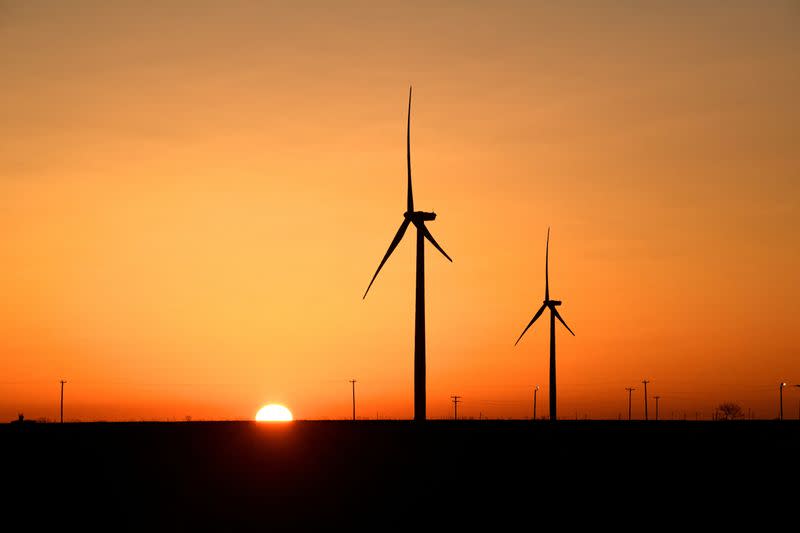U.S. renewable, grid battery projects battle transformer shortage

By Nicole Jao
NEW YORK (Reuters) - U.S. developers building renewable energy projects and power storage for grids are scrambling to procure critical components, leading to rising costs and project delays.
Supply chain problems have tightened supply of high-voltage transformers necessary to connect wind and solar farms and batteries to the grid, projects that are key to the energy transition.
The long lead-time for delivery of the transformers, which can be the size of a large truck and need to be custom built, has forced some project developers to order equipment before commercial agreements to sell power from the projects are in place, said Vanessa Witte, senior energy storage analyst at Wood Mackenzie.
That and the higher prices they are paying for the equipment means developers are having to take a big bet on getting all the deals and approvals they need to make a project viable, she added.
"It's incredibly risky," she said.
The delivery time for transformers and other associated equipment has grown from 50 weeks a year ago to 150 weeks now, said Ben Pratt, CEO of Nova Clean Energy, a utility-scale project developer based in Chicago.
"We just have to be open and honest with the off-takers about the impact of delays as we move along," Pratt said, referring to buyers of power from renewable projects.
"We realistically can't hit the original commercial operation date we've been discussing."
Some large developers stockpiled transformers and associated equipment before measures to accelerate the deployment of renewable energy in the government's Inflation Reduction Act (IRA) triggered another spike in demand.
"It was a situation that was easily predictable... but the IRA accelerated something that was already in process," said Reagan Farr, CEO of Silicon Ranch, a solar farm developer.
Silicon Ranch spent over $100 million stockpiling transformers and switchgears, Farr said. Developers that did not pre-order equipment are paying a lot more for large transformers and have a lead time for delivery of at least three years, he said.
The IRA, signed into law in August 2022, provides billions in green energy tax credits to accelerate and increase the installation and deployment of renewable energy.
LONGER LEAD TIMES
Large-scale battery projects to store energy on grids and to smooth out the variance of wind and solar power are also seeing longer lead times. They are taking around 12 to 18 months to complete, around six months longer than they would take without the supply issues, said Andrew Waranch, chief executive of battery energy storage system developer Spearmint Energy.
That has improved since the summer, when completion time reached about 100 weeks, he said.
"The biggest bottleneck I face today, and most developers face today is (procuring) transformers, substation equipment ... simple, old-fashioned electrical engineering equipment," Waranch said.
Developers added a record 1,510 megawatts (MW) of grid-scale battery storage in the second quarter, according to a report from Wood Mackenzie and the American Clean Power Association. That, however, was lower than anticipated because of the supply chain problems.
For the full year, developers and power plant owners plan to add 9,400 MW of battery storage capacity to the existing total of 8,800 MW, according to the U.S. Energy Information Administration. The capacity is expected to nearly double again to reach 30,000 MW by 2025.
Swiss-based Energy Vault, which provides equipment and other services to power producers in the U.S., has started to bake in longer timelines and higher costs for storage projects to minimize the impact of delays, said Marco Terruzzin, chief commercial and product officer.
Utility AES Corp has stockpiled supplies of the equipment it needs to build battery storage projects through 2025, a company spokesperson said.
A shortage of raw materials that has contributed to transformer supply delays is unlikely to ease soon, manufacturers said.
Electrical steel supplies have been tight since the pandemic due to factory shutdowns in China, said Doug Banty, president and chief operating officer at MGM Transformer, a California-based transformer manufacturer.
"This is an industry that is not accustomed to rapid production expansion ... most of us are playing catch up," Banty said.
Export restrictions imposed on Russia after it invaded Ukraine exacerbated the shortages, said Banty.
The supply-demand dislocation has worsened with the rapid scale-up of wind, solar and storage projects.
U.S. producers have been slow to expand capacity due to the expense, John Darby, president of Niagara Transformer, a New York-based manufacturer.
(Reporting by Nicole Jao; Editing by Simon Webb and Nick Zieminski)


